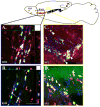Impaired neurogenesis is an early event in the etiology of familial Alzheimer's disease in transgenic mice
- PMID: 20209626
- PMCID: PMC3696038
- DOI: 10.1002/jnr.22387
Impaired neurogenesis is an early event in the etiology of familial Alzheimer's disease in transgenic mice
Abstract
Formation of new neurons in the adult brain takes place in the subventricular zone and in the subgranule layer of the dentate gyrus throughout life. Neurogenesis is thought to play a role in hippocampus- and olfaction-dependent learning and memory. However, whether impairments in neurogenesis take place in learning and memory disorders, such as Alzheimer's disease, is yet to be established. Importantly, it remains to be elucidated whether neurogenic impairments play a role in the course of the disease or are the result of extensive neuropathology. We now report that transgenic mice harboring familial Alzheimer's disease-linked mutant APPswe/PS1DeltaE9 exhibit severe impairments in neurogenesis that are evident as early as 2 months of age. These mice exhibit a significant reduction in the proliferation of neural progenitor cells and their neuronal differentiation. Interestingly, levels of hyperphosphorylated tau, the cytotoxic precursor of the Alzheimer's disease hallmark neurofibrillary tangles, are particularly high in the neurogenic niches. Isolation of neural progenitor cells in culture reveals that APPswe/PS1DeltaE9-expressing neurospheres exhibit impaired proliferation and tau hyperphosphorylation compared with wildtype neurospheres isolated from nontransgenic littermates. This study suggests that impaired neurogenesis is an early critical event in the course of Alzheimer's disease that may underlie memory impairments, at least in part, and exacerbate neuronal vulnerability in the hippocampal formation and olfaction circuits. Furthermore, impaired neurogenesis is the result of both intrinsic pathology in neural progenitor cells and extrinsic neuropathology in the neurogenic niches. Finally, hyperphosphorylation of the microtubule-associated protein tau, a critical player in cell proliferation, neuronal maturation, and axonal transport, is a major contributor to impaired neurogenesis in Alzheimer's disease.
Figures







Similar articles
-
Complex environment experience rescues impaired neurogenesis, enhances synaptic plasticity, and attenuates neuropathology in familial Alzheimer's disease-linked APPswe/PS1DeltaE9 mice.FASEB J. 2010 Jun;24(6):1667-81. doi: 10.1096/fj.09-136945. Epub 2010 Jan 19. FASEB J. 2010. PMID: 20086049 Free PMC article.
-
Voluntary Running Attenuates Memory Loss, Decreases Neuropathological Changes and Induces Neurogenesis in a Mouse Model of Alzheimer's Disease.Brain Pathol. 2016 Jan;26(1):62-74. doi: 10.1111/bpa.12255. Epub 2015 May 7. Brain Pathol. 2016. PMID: 25763997 Free PMC article.
-
Increased hippocampal neurogenesis in the progressive stage of Alzheimer's disease phenotype in an APP/PS1 double transgenic mouse model.Hippocampus. 2009 Dec;19(12):1247-53. doi: 10.1002/hipo.20587. Hippocampus. 2009. PMID: 19309037
-
Neurogenesis and Alzheimer's disease: at the crossroads.Exp Neurol. 2010 Jun;223(2):267-81. doi: 10.1016/j.expneurol.2009.08.009. Epub 2009 Aug 19. Exp Neurol. 2010. PMID: 19699201 Free PMC article. Review.
-
The neurogenic niche in Alzheimer's disease.Neurosci Lett. 2021 Sep 25;762:136109. doi: 10.1016/j.neulet.2021.136109. Epub 2021 Jul 13. Neurosci Lett. 2021. PMID: 34271133 Free PMC article. Review.
Cited by
-
Early onset of hypersynchronous network activity and expression of a marker of chronic seizures in the Tg2576 mouse model of Alzheimer's disease.PLoS One. 2015 Mar 13;10(3):e0119910. doi: 10.1371/journal.pone.0119910. eCollection 2015. PLoS One. 2015. PMID: 25768013 Free PMC article.
-
Adult hippocampal neurogenesis and its role in Alzheimer's disease.Mol Neurodegener. 2011 Dec 22;6:85. doi: 10.1186/1750-1326-6-85. Mol Neurodegener. 2011. PMID: 22192775 Free PMC article. Review.
-
Alzheimer's Disease and Hippocampal Adult Neurogenesis; Exploring Shared Mechanisms.Front Neurosci. 2016 May 3;10:178. doi: 10.3389/fnins.2016.00178. eCollection 2016. Front Neurosci. 2016. PMID: 27199641 Free PMC article. Review.
-
Complex environment experience rescues impaired neurogenesis, enhances synaptic plasticity, and attenuates neuropathology in familial Alzheimer's disease-linked APPswe/PS1DeltaE9 mice.FASEB J. 2010 Jun;24(6):1667-81. doi: 10.1096/fj.09-136945. Epub 2010 Jan 19. FASEB J. 2010. PMID: 20086049 Free PMC article.
-
Functional Deficits of 5×FAD Neural Stem Cells Are Ameliorated by Glutathione Peroxidase 4.Cells. 2022 May 28;11(11):1770. doi: 10.3390/cells11111770. Cells. 2022. PMID: 35681465 Free PMC article.
References
-
- Aimone JB, Wiles J, Gage FH. Potential role for adult neurogenesis in the encoding of time in new memories. Nature neuroscience. 2006;9(6):723–727. - PubMed
-
- Albers MW, Tabert MH, Devanand DP. Olfactory dysfunction as a predictor of neurodegenerative disease. Curr Neurol Neurosci Rep. 2006;6(5):379–386. - PubMed
-
- Arriagada PV, Growdon JH, Hedley-Whyte ET, Hyman BT. Neurofibrillary tangles but not senile plaques parallel duration and severity of Alzheimer’s disease. Neurology. 1992;42(3 Pt 1):631–639. - PubMed
-
- Ashe KH. Learning and memory in transgenic mice modeling Alzheimer’s disease. Learning & memory (Cold Spring Harbor, NY. 2001;8(6):301–308. - PubMed
-
- Bacon AW, Bondi MW, Salmon DP, Murphy C. Very early changes in olfactory functioning due to Alzheimer’s disease and the role of apolipoprotein E in olfaction. Ann N Y Acad Sci. 1998;855:723–731. - PubMed
MeSH terms
Substances
Grants and funding
LinkOut - more resources
Full Text Sources
Other Literature Sources
Medical
Molecular Biology Databases

